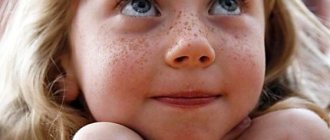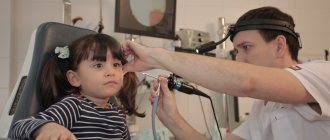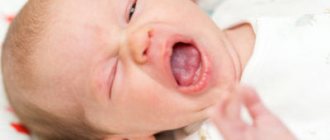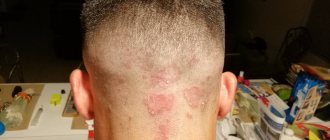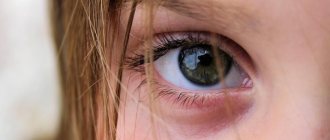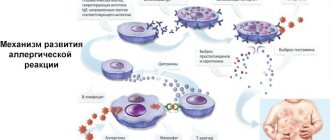Redness of the cheeks in children is a symptom indicating the development of a disease. Most often, these manifestations in babies occur as a result of an allergic reaction to food, milk or external irritants. Similar signs may appear for other reasons. The tendency of children to various kinds of diseases is due to an incompletely formed immune system.
Many parents believe that flushed cheeks are a sign of health. But peeling skin, the appearance of rashes and red streaks on the face do not just happen. In this case, you should consult a doctor and not let the situation take its course, especially if the manifestations are accompanied by itching, cause discomfort to the baby and affect his behavior.
When is redness “safe”?
The skin of small children is very delicate, and in some situations increased blood circulation turns it blush. Before you get scared and wonder why your child has red cheeks, rule out external factors. Perhaps the baby is wrapped up too much and is just too hot?
Or have you just returned from a walk? The frosty winter air stings children and adults. A red face after going outside is normal.
After active play, the baby will definitely have a rosy face. As you move, blood circulation increases and your cheeks change color.
This redness is safe for a healthy child and disappears over time.
Prevention of frostbite
Now, knowing about my daughter’s sensitive skin, I follow some rules and tips:
- Good ointments, creams, balms that protect the skin from chapping and frostbite should not contain water (Aqua). The vast majority of protective products consist of water, therefore, to protect the skin, it is important to use them correctly, so as not to make things worse: apply the cream to the skin at least 20-30 minutes before going outside. Or better yet, 1 hour. If you apply this cream immediately before going outside, the water will freeze on your cheeks and this will speed up frostbite. Personally, I preferred not to mess with creams containing water at all.
- Before your walk, be sure to check the weather forecast (temperature, humidity, wind). If the humidity is high and the wind is strong, it is better not to go out or take a short walk (15-20 minutes), after applying a good protective cream to your cheeks.
- Do not wrap your child in a scarf. Moisture will accumulate on the scarf, cheeks, and lips, which, together with the wind, will lead to frostbite on the cheeks.
The main causes of red cheeks
Many babies' cheeks turn red and are not always an indicator of health. Sometimes diseases or malfunctions of the body manifest themselves as an unnatural blush or rash. These factors deserve increased attention from parents and require consultation with a pediatrician.
Temperature
If a child rarely spends time in the fresh air, he becomes susceptible to infections and his immunity decreases. The baby more often catches viral diseases, and fever is always accompanied by red cheeks in the child, the blood vessels dilate in an effort to give off excess heat.
Typically, a feverish state is accompanied by bright red, clearly defined spots on the cheeks. The eyes have an unhealthy shine, breathing is heavy. Take the temperature.
Overfeeding
This rarely happens with natural feeding, because the newborn literally “extracts” food from the mother’s breast by diligent sucking, and sometimes even perspires. Therefore, the feeling of satiety comes quickly. The same cannot be said about bottle-fed babies, for whom food literally pours from a bottle into their mouth, which means they eat faster. The feeling of fullness comes after 10-15 minutes, so the baby overeats, and the excess immediately stains his cheeks.
What is the way out of this problem? A small hole in the nipple of the bottle so that the baby has time to work hard.
Frostbite and overheating
You should go for a walk with your child in any weather, but in severe frosts it is better to stay at home. The delicate skin on the face can suffer even at -10-15 degrees, especially when there is wind outside. If you notice white spots on your rosy cheeks, it’s time to run home to warm up, otherwise frostbite may set in. Before walking on frosty days, lubricate your face with rich baby cream, it will protect against adverse external factors.
The opposite situation is overheating. In hot weather, under the open sun, the baby may overheat. If you notice his red cheeks, take him to the shade and give him water. And to prevent sunburn, use special children's protective creams and don't forget about Panama hats.
Diathesis
Atopic dermatitis, also known as diathesis, causes not only red cheeks, but also a rash on other parts of the body. It occurs quite often in children, and if certain rules are followed, it can be reduced or avoided altogether.
This is usually a genetic predisposition and appears in newborns in the first year of life. Such babies are born large and gain weight above average, diaper rash appears in the folds of the skin, and yellowish scales appear on the head. The cheeks become covered with rough spots, and later rashes appear.
The diathesis goes away by the age of three, but can develop into eczema or bronchial asthma. That is why children with this disease should be shown to an allergist and all instructions should be followed exactly.
Prevention:
- It is better to underfeed than to overfeed.
- Eliminate modern household chemicals from everyday use.
- Monitor the reaction to cow's or goat's milk protein.
- Use clothes only made from natural fabrics.
- Pay attention to external allergens: fish food, pet hair, flowering plants, honey.
Allergy
Cheeks can turn red from both food allergies and contact allergies.
Be sure to eliminate chlorine household chemicals and washing powders with aggressive ingredients from your use. Wash children's clothes only with hypoallergenic products. Since tap water is chlorinated, rinse your laundry in boiled water after washing. The baby should also be bathed in water free of chlorine.
Without regret, get rid of carpets on walls and floors, soft toys and heavy curtains - these are known dust collectors that can cause a lot of trouble for children prone to allergies. Feather pillows and feather beds are definitely thrown away! Books, of course, are a source of knowledge, but it is better to hide book dust away from the baby behind glass or in another room.
More and more often there are children who, from the first months of life, react with reddening of their cheeks to the most natural and healthy food for them - milk. This does not apply to mother's breastfeeding, this refers to cow's milk.
After six months, the baby begins to be given milk porridge as complementary food, and sometimes it happens that the body begins to produce antibodies to a foreign protein-antigen, which are manifested, among other things, by redness of the cheeks.
Carefully monitor new foods in your child’s diet, give them a little at a time and watch the reaction. Citrus fruits, strawberries, honey, despite their usefulness, can turn out to be strong allergens and manifest themselves as a rash or more terrible symptoms: difficulty breathing or swelling.
Eczema
Diathesis or atopic dermatitis often develops into a more complex disease - eczema. Bubbles and blisters merge into a common mass, burst, become inflamed, and turn into wet lesions and crusts.
Causes of eczema:
- Hereditary factor.
- Poor nutrition.
- Metabolic disease.
- Infections.
- Some medicines.
- Endocrine diseases.
Roseola infantile
It is quite common in children under two years of age, but the mechanism of the disease has not been fully studied. For no apparent reason, the temperature rises, and after a few days the face and body are covered with raised pink rashes. At the same time, no other symptoms are observed, nothing bothers the child. The disease is easy and does not cause complications.
Scarlet fever
Just a few decades ago, this infectious disease caused by streptococcus terrified parents due to complications and increased mortality. Now they have learned to treat it without serious consequences, the main thing is not to waste time. The danger is not the bacterium itself, but its decay products, which cause severe intoxication of the body.
Scarlet fever is difficult to confuse with another disease - the cheeks are bright red due to the rash, and the nasolabial triangle is pale. The tongue is without plaque, with enlarged papillae, and resembles a raspberry. The tonsils are enlarged and hyperemic. The rash is concentrated in the flexure areas of the limbs. The skin on the palms and soles peels and flakes off. The temperature often rises above 39 degrees and is difficult to bring down.
Transmitted by airborne droplets.
Scarlet fever
Causative agent: group A beta-hemolytic streptococcus.
Method of transmission: airborne. The pathogen is transmitted by talking, coughing, and using common household items (dishes, toys, etc.).
Immunity: after illness - lifelong.
Infectious period: the first few days of the disease.
Manifestations: the disease begins in the same way as a regular sore throat (sore throat, fever). Rashes characteristic of scarlet fever appear on the 1st-3rd day from the onset of the disease. The rash is small, bright pink, located mainly on the cheeks, groin and sides of the body and goes away within days. The nasolabial triangle remains pale and free of rash - this is the hallmark of scarlet fever. After the rash disappears, the skin on the palms and soles begins to actively peel off.
Treatment: only broad-spectrum antibiotics. It is very important to start treatment as early as possible, because... Scarlet fever can trigger the development of autoimmune diseases such as rheumatism, glomerulonephritis, and autoimmune brain damage.
What to do if your baby’s cheeks are “burning”?
One day you notice that your child has an unusual cheek color. Your actions?
First of all, make sure there is no elevated temperature. If it does not exceed 38 degrees, then do not take any action, but limit the baby’s activity. Fever is the body’s protective reaction to viruses; do not interfere with the immune system’s ability to fight infection. But when the thermometer rises higher, then it’s time for antipyretics.
A common cold can be treated at home, but if the fever lasts for several days, you should call a doctor.
Red cheeks with obvious signs of a rash are a reason to visit a doctor, especially if there are other symptoms of illness or the rash appears regularly.
If you have allergic reactions, do not delay your visit to a pediatric allergist. It is necessary to undergo an examination and identify allergens in order to subsequently eliminate them. The doctor will also create an individual treatment plan for the child.
Herpes simplex
Causative agent: herpes simplex virus. There are two types: herpes simplex virus type I causes rashes in the mouth, type II - in the genital area and anus.
Method of transmission: airborne droplets and contact (kissing, shared household items, etc.).
Immunity: not developed, the disease occurs with periodic exacerbations due to stress or other infections (ARVI, etc.).
Incubation period: 4-6 days.
Contagious period: all the time of rash.
Manifestations: a few days before the rash appears, itching and soreness of the skin may occur. Then a group of closely spaced bubbles will appear in this place. The temperature rises extremely rarely.
Red hot cheeks of a child
It is impossible to answer the question why a baby has red cheeks; it is quite difficult to determine the real reason without a medical examination. After all, there are a lot of reasons that cause redness.
- Red cheeks in a child can occur due to overheating when the baby is dressed too warmly. In this case, it is enough to change the child’s clothes and give him water.
- A high temperature can also cause red cheeks, so you should take your temperature before taking the next steps and, if it is high, see a doctor.
- The most common causes of red cheeks include diathesis and allergic reactions. Diathesis occurs against the background of allergies with a whole range of disorders in the baby’s body. Allergies become a catalyst for the onset of this disease process. To treat both allergies and diathesis, you need to find the allergen and eliminate it. Anti-allergy creams and medications are also usually prescribed.
Rubella
Pathogen: rubella virus
Method of transmission: airborne. The virus is transmitted through communication, coughing, and talking.
Immunity: lifelong. It is produced either after an illness or after vaccination. For children whose mothers had rubella or were vaccinated against it, immunity to rubella is transmitted in utero and persists for the first 6-12 months of life.
Incubation period: from 11 to 24 days.
Infectious period: from the 7th day from infection until the rash completely disappears + another 4 days.
Manifestations: temperature rises. A small, pale pink, non-itchy rash appears on the face, limbs, and torso, and at the same time the posterior cervical lymph nodes enlarge. The temperature lasts no more than 2-3 days, and the rash goes away on the 2-7th day from its onset.
Treatment: symptomatic therapy only: drinking plenty of fluids, lowering the temperature if necessary, etc. Children tolerate the disease easily, but adults often experience complications. Rubella is especially dangerous in the first trimester of pregnancy: the virus crosses the placenta and causes congenital rubella in the baby, which can result in deafness, cataracts or heart defects in the newborn. Therefore, everyone, especially girls, is strongly recommended to undergo vaccination against this disease.
Red spots on the cheeks of a child: causes
- Red spots on the cheeks can occur due to erythema infectiosum. Before red spots appear on the cheeks, the child has 4 days of cold symptoms such as fever, runny nose, headache, nausea, and vomiting. After this, red spots appear with simultaneous paleness of the skin around the lips.
- Red spots can also be a consequence of the disease systemic lupus erythematosus, which also manifests itself as erythema, but spreads from the tip of the nose to the cheeks in the form of a butterfly. Sometimes accompanied by a rash, as with measles. But it is always accompanied by serious symptoms: damage to the joints, kidneys, spleen, and the onset of fever.
- Red-lilac spots on the cheeks appear with dermatomyositis. Accompanied by general weakness, fever, apathy, adynamia, progressive muscle weakness, red spots on the feet and under the eyes.
- Red spots on the cheeks may appear due to infantile roseola. It is characterized by a rapid rise in temperature, after 3 days - the appearance of loose stools with mucus, and then the appearance of red spots and a rash throughout the body. There is no runny nose or cough.
- Red spots on the cheeks may appear due to allergic subsepsis of Wissler, ring-shaped erythema, bacterial sepsis, meningococcal meningitis, Steven-Johnson syndrome. Almost always, all serious diseases are accompanied by the appearance of red spots on the cheeks, but before their appearance, symptoms of the disease already appear.
In order to make an accurate diagnosis, you should definitely seek help from a doctor; only he can prescribe the necessary treatment and cope with the disease.
Roseola
(sudden exanthema, sixth disease)
Causative agent: another representative of the glorious family of herpes viruses is the herpes type virus.
Method of transmission: airborne. The infection spreads through talking, socializing, sneezing, etc.
Immunity: after illness - lifelong. Children under 4 months have immunity received in utero from their mother. Incubation period:
Infectious period: throughout the illness.
Manifestations: a sudden rise in temperature and after a few days its spontaneous decrease. Simultaneously with the normalization of the temperature, a pink, small- and medium-spotted rash appears. It is located mainly on the torso and, as a rule, does not cause itching. Goes away on its own after 5 days.


